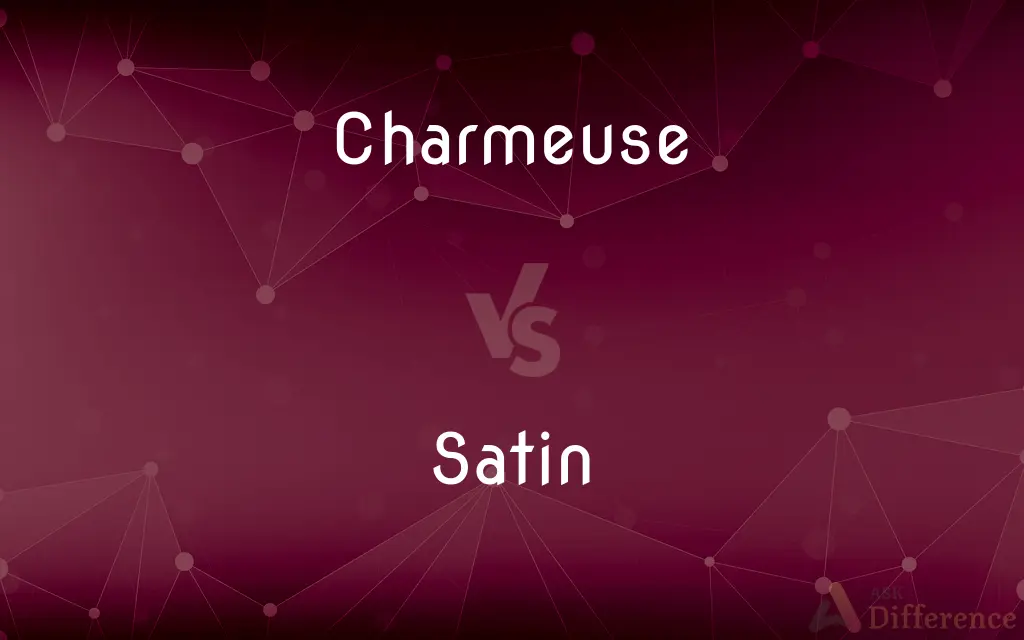Charmeuse vs. Satin — What's the Difference?
By Fiza Rafique & Urooj Arif — Updated on March 15, 2024
Charmeuse is a lightweight, soft fabric known for its lustrous sheen on one side and matte finish. Satin, however, is a weave that produces a smooth, glossy surface on one side.

Difference Between Charmeuse and Satin
Table of Contents
ADVERTISEMENT
Key Differences
Charmeuse and satin refer to materials often used in the fashion and textile industries, known for their glossy appearance and smooth texture, but they differ in composition and characteristics. Satin, on the other hand, is a more general term that describes any fabric constructed with a satin weave.
The primary distinction between charmeuse and satin lies in the specific feel and drape of charmeuse, which is softer and more delicate due to its silk or high-quality synthetic fibers, compared to the broader category of satin that can include a range of qualities and weights. Charmeuse is often chosen for garments that require a gentle, flowing silhouette, whereas satin's versatility makes it suitable for everything from luxurious evening wear to practical everyday items.
Both charmeuse and satin require careful handling and maintenance due to their delicate weave and glossy surface, which can be prone to snagging and marks. However, the choice between charmeuse and satin often comes down to the desired finish, feel, and the specific use of the fabric, with charmeuse offering an unmistakably rich and refined texture that is hard to replicate with other types of satin.
Comparison Chart
Composition
Silk or synthetic fibers like polyester
Silk, polyester, nylon, cotton
Texture
Lightweight, very soft, fluid drape
Can range from lightweight to heavyweight, smooth
ADVERTISEMENT
Sheen
Lustrous on one side, matte on the other
Glossy surface on one side, dull on the other
Use
Lingerie, evening dresses, high-end bedding
Wide range, including apparel, bedding, upholstery
Feel
Delicate, luxurious
Smooth, luxurious, varies with fiber content
Durability
More delicate, requires careful handling
Varies, generally more durable than charmeuse
Drape
Excellent, fluid
Good to excellent, depending on weight
Maintenance
Often requires dry cleaning, prone to snagging
Depends on fiber content; some types more washable than others
Price
Generally more expensive due to silk content
Ranges widely, depending on fiber content and quality
Compare with Definitions
Charmeuse
A luxurious, lightweight fabric with a glossy sheen on one side and matte on the other, perfect for elegant dresses.
Her silk charmeuse gown flowed gracefully, catching the light.
Satin
A weave that produces a glossy surface, satin is versatile and used in various applications.
The satin curtains added a touch of elegance to the room.
Charmeuse
Known for its excellent drape, charmeuse is often used for lingerie.
The charmeuse silk pajamas offered unparalleled softness and comfort.
Satin
Available in a range of weights and qualities, satin can suit many needs.
The designer used a heavy satin for the winter coat to add warmth and sheen.
Charmeuse
Despite its delicate nature, charmeuse's allure lies in its unmatched softness.
The bridal collection featured charmeuse veils for their soft glow.
Satin
Its lustrous finish is achieved through the satin weave technique.
The glossy finish of her dress was the result of a finely crafted satin weave.
Charmeuse
Requires careful handling to maintain its beauty.
She dry-cleaned her charmeuse blouse to preserve its lustrous finish.
Satin
Satin's smooth texture makes it a favorite for formal wear.
His black satin tie complemented the tuxedo perfectly.
Charmeuse
Often chosen for high-end apparel and bedding for its refined texture.
The luxury bedding set was made of pure silk charmeuse for an opulent feel.
Satin
Some satin fabrics are more durable and easier to care for, depending on the fibers used.
The polyester satin sheets offered both luxury and ease of care.
Charmeuse
Charmeuse (French: [ʃaʁmøz]), from the French word for female charmer, is a lightweight fabric woven with a satin weave, in which the warp threads cross over four or more of the backing (weft) threads. These float threads give the front of the fabric a smooth, shiny finish, whereas the back has a dull finish.
Satin
A satin weave is a type of fabric weave that produces a characteristically glossy, smooth or lustrous material, typically with a glossy top surface and a dull back. It is one of three fundamental types of textile weaves alongside plain weave and twill weave.
Charmeuse
A satin-finished silk fabric.
Satin
A smooth, often silk fabric that is woven with a glossy face and a dull back.
Charmeuse
A fine semi-lustrous crepe in satin weave.
Satin
A garment made of this fabric.
Satin
A kind of paint that dries to a smooth shiny finish.
Satin
Made of or covered with satin.
Satin
Glossy, sleek, and smooth.
Satin
A cloth woven from silk, nylon or polyester with a glossy surface and a dull back. (The same weaving technique applied to cotton produces cloth termed sateen).
Satin
Semigloss.
Satin paint
Satin
(transitive) To make (paper, silver, etc.) smooth and glossy like satin.
Satin
A silk cloth, of a thick, close texture, and overshot woof, which has a glossy surface.
Cloths of gold and satins rich of hue.
Satin
A smooth fabric of silk or rayon; has a glossy face and a dull back
Common Curiosities
Can I machine wash satin and charmeuse fabrics?
Care instructions vary. Silk charmeuse typically requires dry cleaning, while some synthetic satin fabrics may be machine washable. Always check the fabric care label.
Why is charmeuse often more expensive than other satins?
The cost of charmeuse, especially silk charmeuse, is higher due to the luxurious material and the intricate weaving process required to achieve its distinctive softness and drape.
Is satin always shiny?
Satin has a glossy surface on one side due to the satin weave, but the degree of shine can vary depending on the fibers used and the weave density.
What is the key difference between charmeuse and satin?
Charmeuse is a specific type of satin known for its luxurious feel and fluid drape, usually made of silk or fine synthetic fibers, while satin refers to fabrics with a glossy surface produced by the satin weave, using various fibers.
Which is better for summer clothing, charmeuse or satin?
Charmeuse, especially when made of silk, is often preferred for summer due to its breathability and light weight, although lightweight satin made from synthetic fibers can also be a good choice.
Are charmeuse and satin suitable for sensitive skin?
Both fabrics are smooth and can be gentle on the skin, but silk charmeuse, in particular, is renowned for its hypoallergenic properties and softness, making it suitable for sensitive skin.
Can charmeuse be made of materials other than silk?
Yes, charmeuse can also be made from synthetic fibers like polyester, offering a similar feel and appearance to silk charmeuse.
How do I identify charmeuse from other types of satin?
Charmeuse is distinguishable by its exquisite drape, softness, and the matte finish on the reverse side, unlike other satins that may have a slightly stiffer feel and less pronounced difference between the two sides.
Why do brides often choose charmeuse for their gowns?
Brides choose charmeuse for its elegant sheen, luxurious feel, and flattering drape, which make it ideal for creating sophisticated and romantic wedding gowns.
Is charmeuse or satin better for hair accessories?
Both can be good for hair accessories, but satin made from silk or high-quality polyester is often chosen for its smoothness that reduces hair breakage and frizz.
Share Your Discovery

Previous Comparison
Colander vs. Strainer
Next Comparison
Cadence vs. TimbreAuthor Spotlight
Written by
Fiza RafiqueFiza Rafique is a skilled content writer at AskDifference.com, where she meticulously refines and enhances written pieces. Drawing from her vast editorial expertise, Fiza ensures clarity, accuracy, and precision in every article. Passionate about language, she continually seeks to elevate the quality of content for readers worldwide.
Co-written by
Urooj ArifUrooj is a skilled content writer at Ask Difference, known for her exceptional ability to simplify complex topics into engaging and informative content. With a passion for research and a flair for clear, concise writing, she consistently delivers articles that resonate with our diverse audience.














































